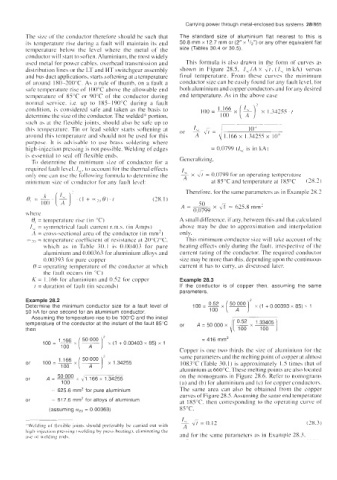Page 914 - Industrial Power Engineering and Applications Handbook
P. 914
Carrying power through metal-enclosed bus systems 28/865
The sir.e of the conductor therefore should be such that The standard size of aluminium flat nearest to this is
its temperature rise during a fault will maintain its end 50.8 mm x 12.7 mm or (2" x 1/2'') or any other equivalent flat
temperature below the level where the metal of the size (Tables 30.4 or 30.5).
conductor will start to soften. Aluminium. the most widely
used metal for power cables. overhead transmission and This formula is also drawn in the form of curves as
distribution lines or the LT and HT switchgear assembly shown in Figure 28.5, l,c/A x yit. (I,' in kA) versus
and bu$ duct applications. starts softening at a temperature final temperature. From these curves the minimum
of around 180-200°C. A\ a rule of thumb, on a fault a conductor size can be easily found for any fault level, for
safe temperature rise of 100°C above the allowable end both aluminium and copper conductors and for any desired
temperature of 85°C or 90°C of the conductor during end temperature. As in the above ca\e
norinal service. i.e. up to 185-1 90°C during a fault
condition, is considered safe and taken as the basis to
determine the size of the conductor. The welded" portion,
such a\ at the flexible joints. should also be safe up to
thi4 temperature. Tin or lead solder starts softening at or vG = I IO4
A
around this temperature and should not be used for this - 4 1.166 x 1.34255 x IO"
purpose. It is ad\isable to use brass soldering where
high-injection pressing is not possible. Welding of edges = 0.0799 (/\c is in kAj
is essential to sen1 off flexible ends.
T'o determine the minimum size of conductor for a GeneraliLing,
required fault level. I,,, to account l'or the thermal effects I,,
x
on11 one can use the following forinula to determine the - ?G = 0.0799 for an operating temperature
A
iiiiniinuin size of' conductor for any fault lewl: at 85°C and temperature at 1XS"C (18.2)
Therefore. for the same parameters as in Example 28.2
(28.1 )
A=- x & --- 6253 nim'
u here 0.0799
0, = temperature rise (in "C) A small difference, if any. between this and that calculated
I,, = syminetrical fault current r.m.s. (in Amps) above may be due to approximation and interpolation
'4 = cross-sectional area of the conductor (in mm') only.
0c2,, = temperature coefficient of resistance at 20"C/"C, This minimum conductor six will take account of the
which as in Table 30.1 is 0.00403 for pure heating effects only during the fault. irrespective of the
aluminium and 0.00363 for aluminium alloys and current rating of the conductor. The required conductor
0.00793 for pure copper size may be more than this. depending upon the continuous
H = operating temperature of the conductor at which current it has to carry, as discussed latcr.
the fault occurs (in "C)
K = I. 166 for aluminium and 0.52 for copper Example 28.3
/ = duration of fault (in seconds) If the conductor is of copper then, assuming the same
parameters,
Example 28.2
Determine the minimum conductor size for a fault level of 100 = 0.52 X (F 1' x (1 + 0 00393 x 85) Y 1
50 kA for one second for an aluminium conductor. 100
Assuming the temperature rise to be 100°C and the initial
temperature of the conductor at the instant of the fault 85°C
then
100 = 'E [?I* x (1 + 0.00403 x 85) x 1 = 416 mm2
x
100
Copper is one two thirds the size of aluminium for the
same parameters and the melting point of copper at almost
1083°C (Table 30.1) is approximately I .S times that of
aluminium at 660°C. These melting points are also located
or A=- 50000 x t'i1.166x1.34255 on the nomograms in Figure 28.6. Refer to nomograms
100 (a) and (bj for aluminium and (c) for copper conductors.
~ 625 6 mm2 for pure aluminium The same area can also be obtained from the copper
curves of Figure 28.5. Assuming the sane end temperature
or = 617 6 mm2 for alloys of aluminium at 185°C. then corresponding to the operating curve of
(assuming a2,, = 0 00363) 85°C.
I,, -
- dt = 0.12 (28.3)
'.Welding of flexible ,joints \hould preferably be carried out with A
liigh-in,jection pressinf (weldin? hy prem heating). eliminating the
IIW 01 urlding rod\. and for the same parameters as in Example 28.3.

